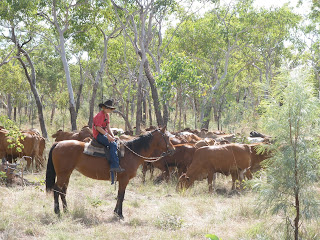Charnley is owned and run by the Camp family, who also run Kalyeeda on the Fitzroy floodplain. I spent a bit of time hanging out with their eldest daughter Hannah in Kununurra (she is a physio at the hospital), and met the middle daughter Camille at a couple of parties. So I rocked up to Charnley to have a look, and see what was going on. When I arrived Camille was sitting outside the kitchen with her mum Sheryl, and the camp cook, and I explained that I knew Hannah etc. Sheryl invited me up to the house for dinner with everybody, station crew, plus the 2 muster chopper pilots and one of the workmens family out from England.
That arvo I checked out Donkey Hole and Junction Pool. Junction pool is a nice little swimming hole surrounded by pandanus at the junction of 2 creeks. The wet season here was pretty dry this year, as it was for most of the Kimberley, so this is the only decent waterhole left. Despite that it doesn't appear to see too much tourist traffic.



I had breakfast at 5 am with everybody, the plan for the day was to shoe the remaining horses needed for the coming 4 days of mustering, and pack up to head out to the stock camp for the start of mustering that afternoon. I went with James (their 21 year old only son) in the bull catcher to check a fence line, which took us a couple of hours, some good little bits of 4wding, a broken brake line, loose tail shaft bolts, and some other funny noises. Then we joined up with the two choppers mustering cattle in an unfenced area along the eastern boundary, after pushing a mob of Brahmans through into the fenced area ourselves. All up we put 339 cattle into the fenced area. Mostly Kimberley Shorthorn cattle that will all get sold, and replaced with Brahmans. Any Shorthorn that doesn't co-operate in the muster gets a bullet rather than being left in the paddock, as they dilute the Brahman genetics. These unfenced areas are the last place on the station for the shorthorns to be replaced.

That afternoon we packed up a circus, and eventually headed to Potts Camp, arriving a bit after dark. We set up camp which involved making a horse yard, unloading 12 horses from the truck, feeding and hobbling them all, whilst the cook and Sheryl got dinner going.
 Part of the circus - this is the water truck for washing up, drinking etc. The engine has no cover on it and is 30cm away from your leg.
Part of the circus - this is the water truck for washing up, drinking etc. The engine has no cover on it and is 30cm away from your leg.In the morning the horses got fed, and saddled, and the riders headed off, following the tracks of Peters bull catcher into the scrub. Peter was driving, aided by the chopper pilots, an obstacle free course to bring the cattle back on. James and I tried to get the other 6 horses (they get ridden alternate days) to stop and drink at the creek, and then back in the yard which was quite an adventure. I had to head back to the homestead with Sheryl so I could head up to Kununurra, but on the way back, we drove in a different route to the spot where the choppers were bringing the cattle for the riders and bull catchers to drove back to the yards. We sat and watched the choppers pushing the cattle up onto the top of the plateau for a couple of hours, then headed off once they had all settled down and everybody had had lunch.




The antics of the 2 chopper pilots Grant and PJ were incredible dropping right down into the trees, and throwing their machines around, unfortunately none of the photos or videos really do it justice.


 Grant Wellington with his R22
Grant Wellington with his R22Australian Wildlife Conservation (AWC) and the Camps are in the process of negotiations over selling the station. I get the feeling it is the AWC structure that slowing things down, but by the note in the directors voices at the Mornington party with Tim Flannery, it sounds like it will happen.
This video is of Peter running over a bull that broke out of the mob. The bull bar on the front of the ctcher is sloped underneath so that you can pin the bull on the ground whilst you strap either front or back legs together with a belt or two. These cattle then get picked up at the end of the day. They are tied because they are a serious risk to the safety of those on horseback, and make droving the cattle more difficult. One of the girls was just touched by the horn of a bull on the hip 10 minutes after this video. Luckily it wasn't a fraction closer or it would have gutted her horse and stabbed her.







